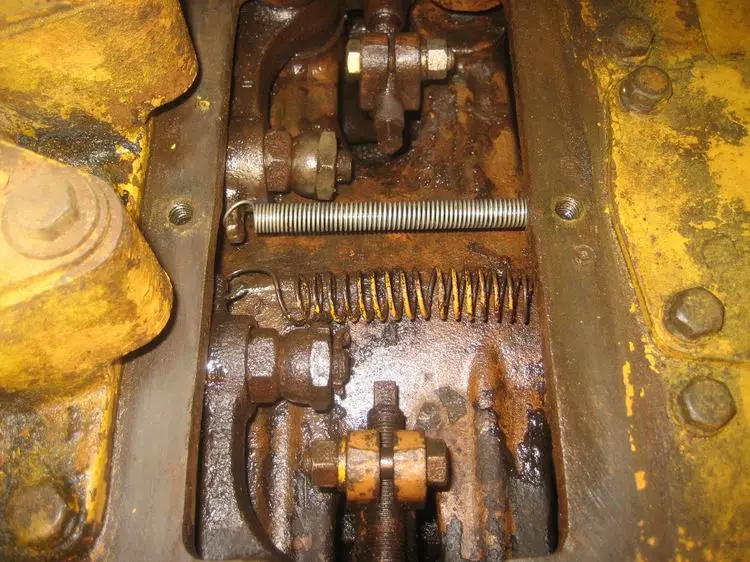1. Clutch plate swelled or rust formed in there. It will need adjusting after it dries out or rust comes out.
BTW I was always taught to leave it disengaged so they don't stick together.
2. I would assume that you started under the plates on the top of the transmission/Finals and found the adjuster for the steering clutches is all used up? If so, then yes you will be tearing into it, put in new Throwout Bearings while you are in there!
Or I maybe wrong on the second one, now that I think about it as the steering clutch plates swell, they levers move backward(memory?).
Either way you need to get the cover plate off and look down in there
If your steering clutches work fine with the levers back close to the seat there is no real problem. As pointed out earlier, with wear, the clutch pack thickness decreases until the lever has moved forward and begins to ride against the bumper and keeps thrust pressure against the release bearing so it wears out faster. This also counteracts some of the spring force that keeps the clutch pack engaged and it will begin to slip under load thereby wearing the clutch faster.
I wonder if someone reassembled yours with aftermarket discs or used disks and added an extra disk to get up to minimum spec but that puts the finished dimension at greater than normal. Of course the discs could be swelled with rust behind the riveted linings and wind up the same.
If you want to move the levers back forward you should be able to lengthen the linkage running back from the base of the levers to the belcrank where the adjuster is.
The other possibility is the release bearings are failing but I don't think they will have run long until you would no longer be able to disengage the clutches. Also unlikely that both of them would have failed in the same manner, to the same degree and at the same time.
If your steering clutches work fine with the levers back close to the seat there is no real problem. As pointed out earlier, with wear, the clutch pack thickness decreases until the lever has moved forward and begins to ride against the bumper and keeps thrust pressure against the release bearing so it wears out faster. This also counteracts some of the spring force that keeps the clutch pack engaged and it will begin to slip under load thereby wearing the clutch faster.
I wonder if someone reassembled yours with aftermarket discs or used disks and added an extra disk to get up to minimum spec but that puts the finished dimension at greater than normal. Of course the discs could be swelled with rust behind the riveted linings and wind up the same.
If you want to move the levers back forward you should be able to lengthen the linkage running back from the base of the levers to the belcrank where the adjuster is.
The other possibility is the release bearings are failing but I don't think they will have run long until you would no longer be able to disengage the clutches. Also unlikely that both of them would have failed in the same manner, to the same degree and at the same time.
In my experience with D2's, when the steering clutch levers lay too far back it's because the clutch packs have begun to swell due to rust. If they're not too bad you can run the adjuster into the pinch nut until the square head is practically buried, and you may regain some clutch release... in most cases it's time for a tear down.
As others have said, with normal wear, the free play decreases and the levers migrate towards the dash... if it gets bad enough the tractor will cease to move under load because the clutches are slipping. To regain the prescribed 3'' of free play under these conditions, back the adjusters towards the center of the tractor.
That's all I got.

[attachment=44549]resize of steer link.jpg[/attachment]
my D2 had some type of nuts added to take up some slack
OK, after reading carefully all your psots, this is what I'm going to do.
I went out and ran the Cat today,(Starting engine started with one pull!) and based on your knowledge posted to me I'm going to leave the clutches alone. Although the adjustment nuts are close to hiding within the cinch clevises there is still considerable working leverage. The tractor steers very well and there are no bad sounds coming from the throwout mechanism.
I assume as I use the cat the levers will migrate toward the dash as the plates wear down. And with my age and the hours the Cat will be used it will be my kids that have to worry about it.
I am however going to remove the track frames and fix the rollers. Also while the track is off I'm going to cut down 4in off the inside of the pads. The outside has already been cut by a previous owner.
Thank you every body for taking an interest and providing such good responses.